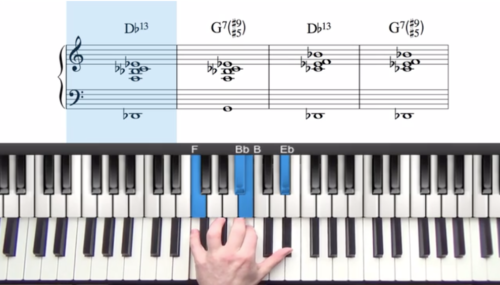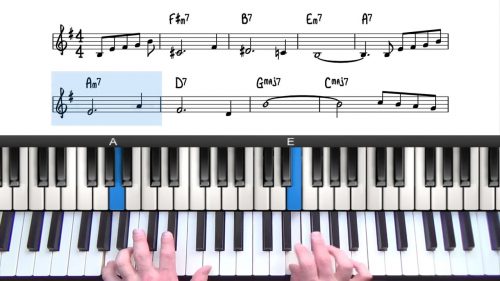Slick Dominant Passing Chords
In this 5 Minute Masterclass we will cover how to play dominant passing chords. Before watching this lesson, you should already understand the concept of tritone substitution – check out the related lessons below for more information.
So How Can We Illustrate A Passing Chord?
In the key of C major, a 251 progression would be D-7, G7 and Cmaj7. If we substitute the G7 for its tritone substitute, we get D-7, Db7 and C. And if we play both dominant chords one after another we can view Db7 as a passing chord into Cmaj7
To take this a step further, we could add a dominant passing chord before the 5 chord, in this 251 progression. The V chord is G7 and a half step above G is Ab so we want some kind of Ab7 chord.
A Strong Pull To Resolve Down A Half Step
It’s important to recognize that this type of passing chord is always a dominant chord built a half step above the target chord. Dominant chords have a strong pull to resolve a half step down which is why this concept works so nicely.
Apply To "The Shadow Of Your Smile"
In this lesson, we will apply the theory to the first 8 bars of “The Shadow Of Your Smile” and add we will explore an exact process that you can use to find great passing chord opportunities.
Practice Tips
-
To identify opportunities to add passing chords. Look for lone melody notes, right before the chord changes.
-
Next, analyse the harmony and work out the "target chord" and then simply move up a half step and build a dominant chord to approach the target.
-
Finally, analyse the melody note. Our goal is to find a voicing with that note on top and then use that vocing to approach the target chord. This is called ' harmonizing the melody note'
-
Dominant Passing Chords sounds great when the melody note you are harmonising is an alteration. In the examples in this lesson, most of the melody notes we harmonise have the #11 in the melody.
-
The alteration adds extra tension which makes the resolution into the target chord even sweeter!
-
Understand that you can create passing chords with any note in the melody, the melody note - it doesn't have to be the #11.
- Much of this is a process of trial and error, so experiment, and have fun!




ok Hayden, I’m trying not to be “giddy” with understanding! I’ve ALWAYS wondered about those “half step above chords” that would be on lead sheets. I didn’t understand the harmonic decision at all — even though i knew about tri-tone substitutions. I didn’t put it together. Really, really clear lesson. Thank you.
Awesome! … You’ve got to love those “Ah-ha” moments when something finally clicks. Such as great feeling 😀
Back to the topic… yes those chromatic half step chords are super useful and you can use them virtually anywhere. Experiment by following the logic in this video and you will be surprised how nicely you can slot these passing chords into your arrangements. “Passing Harmony” is a fascinating subject.
Perhaps you’ve also seen the common approach of a diminished chord a half step below… this is, in fact, the exact same thing going on…
For example, Bdim7 doing to Cmaj7.
Remember that diminished chords are often functioning as a dominant chord in disguise, so you could view that Bdim7 as G7b9 or tritone sub Db7b9 … B(b7) D(b9) F(3) Ab(5) which is the same thing we explained in this video, but rootless, and coming from below… also a nice sound to play around with.
If that doesn’t make sense straight away, keep thinking about it and playing around with it on the piano.
Enjoy!
Hayden
Super useful lesson Hayden – thank you!
My pleasure James.
These tutorials are fun to make!
Cheers,
Hayden
Wow, that was a revelation. I had no idea about this before. Thank you so much Hayden, a great lesson, and very easy to follow and hopefully apply. 🙂
Hi Natasha 👋
Glad to hear that 🙂 You can apply this anywhere and it will help add more interest to common chord progressions.
Remember to experiment with other songs that you are working on by following the same process outlined in the video. Sometimes it will work, other times it might not work, it’s all about experimenting and you will discover lots in the process.
All the best,
Hayden
Great lesson!
One question though. Could sus chords also work as passing chords in an instance where the 11th note is in the melody? Thanks in advance!
Hi Jose,
Good question!
A sus chord is a not a regular dominant chord because it does not contain a tritone interval (major 3rd, and b7th).
The presence of this tritone interval is what creates a strong sense of pull to the chord a 5th away, or te chord a half step below.
This is the core principle behind dominant passing chords, and so when we change the dominant chord to a sus chord, we alter the nature of the chord and where it wants to resolve.
I wouldn’t say it’s impossible to use a sus chord as a passing chord, but I can’t think of a time where I have used this when arranging a jazz standard.
I hope this helps Jose and let me know if you have any further questions.
Cheers, Hayden